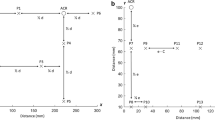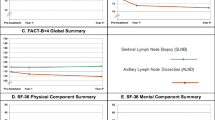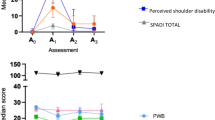Abstract
Background
Morbidity of the shoulder after breast cancer is a well-known phenomenon. MRI studies have shown muscle morbidity in cervical cancer and prostate cancer. In breast cancer clinical observations and patient reports include muscle morbidity in a number of muscles acting at the shoulder. Several of these muscles lie in the field of surgery and radiotherapy. Timed interaction between muscles that stabilise the shoulder and those acting as prime movers is essential to achieve a smooth scapulohumeral rthythm during functional elevation of the arm.
Method: Cross-sectional study
Seventy-four women treated for unilateral carcinoma of the breast were included in the study. All patients filled out the Shoulder Pain and Disability Index (SPADI). EMG activity of four muscles was recorded during scaption on the affected and unaffected side. Muscle cross sectional area and signal intensity was determined from MRI scans. The association between EMG and covariates was determined using multiple linear regression techniques.
Results
Three of the 4 muscles on the affected side demonstrated significantly less EMG activity, particularly when lowering the arm. Upper trapezius demonstrated the greatest loss in activity. Decreased activity in both upper trapezius and rhomboid were significantly associated with an increase in SPADI score and increased time since surgery. Pectoralis major and minor were significantly smaller on the affected side.
Conclusion
Muscles affected in the long term are the muscles associated with pain and disability yet are not in the direct field of surgery or radiotherapy. Primary muscle shortening and secondary loss of muscle activity may be producing a movement disorder similar to the ‘Dropped Shoulder Syndrome’. Exercise programmes should aim not only for range of movement but also for posture correction and education of potential long-term effects.
Similar content being viewed by others
References
Mamounas EP (2005) Continuing evolution in breast cancer surgical management. J Clin Onc 23(8):1603–1606
Box RC, Reul-Hirche H, Bullock-Saxton JE, Furnival C (2002) Shoulder movement after breast cancer surgery: results of a randomised controlled study of postoperative physiotherapy. Br Canc Res Treatment 75(1):35–45
Rietman J, Dijkstra P, Hoekstra H, Eisman W, Szabo B, Groothoff J, Geertzen J (2003) Late morbidity after treatment of breast cancer in relation to daily activities and quality of life: a systematic review. Eur J Surg Oncol 29:229–238
Gossenlink R, Rouffaer L, vanhelden P, Piot W, Troosters T, Christiaens M (2003) Recovery of upper limb function after axillary dissection. J Surg Oncol 83:204–211
Rezvani M, Hopewell JW, Robbins MEC (1995) Initiation of on-neoplastic late effects: the role of endothelium and connective tissue. Stem Cells 13(suppl 1):248–256
Wedgewood KR, Benson EA (1992) Non-tumour morbidity and mortality after modified radical mastectomy. Ann Royal College Surg Engl 74:314–317
Soulen RL, Romero JA, Chuba PJ et al (1997) Musculoskeletal complications of neutron therapy for prostate cancer. Radiat Oncol Investig 5(2):81–91
Aitken RJ, Gaze MN, Rodger A et al (1989) Arm morbidity within a trial of mastectomy and either nodal sample with selective radiotherapy or axillary clearance. Br J Surg 76:568–571
Blomlie V, Rofstad EK, Tvera K, Lien HH (1996) Non-critical soft tissues of the female pelvis: Serial MR imaging before, during and after radiation therapy. Radiology 199:461–468
Gutman H, Kersz T, Barzilai T et al (1990) Achievements of physical therapy in patients after modified radical mastectomy compared with quadrantechtomy, axillary dissection and radiation for carcinoma of the breast. Arch Surg 125:389–391
McConnell J (1994) The McConnell approach to the problem shoulder, Chapter 3. Course notes, McConnell Institute, Neutral Bay
Gerber L, Lampert M, Wood C et al (1992) Comparison of pain, motion and oedema after modified radical mastectomy versus local excision with axillary dissection and radiation. Breast Cancer Res Treat 21:139–145
Keramopoulos A, Tsionou C, Minaretzis D et al (1993) Arm morbidity following treatment of breast cancer of total axillary dissection: a multivariated approach. Oncology 50:445–449
Sneeu KCA, Arenson NK, Jaarnold JR (1992) Cosmesis and functional outcomes of breast conserving treatments for early stage breast cancer. Comparisons of patients ratings, observers ratings and objective measurements: a multivariate approach. Radiother Oncol 25:1532–1539
Kuehn T, Klauss W, Darsow M, regele S, Flock F, Maiterth C et al (2000) Long term morbidity following axillary dissection in breast cancer patients – clinical assessment, significance for life quality and the impact of demographic, oncologic and therapeutic factors. Breast Cancer Res Treat 64:275–286
Donatelli RA (2000) Physical therapy of the shoulder, 3rd edn. Churchill Livingstone Inc
Richardson C, Jull G (1995) Muscle control-pain control. What exercises would you prescribe? Manual Therapy 1(1):1–9
Mcquade KJ, Dawson J, Smidt GL (1995) Scapulothoracic muscle fatigue associated with alterations in scapulohumeral rhythm kinematics. J Orthop Sports Phys Ther 28(2):74–84
Babyar SR (1996) Excessive scapular motion in individuals recovering from painful and stiff shoulders: causes and treatment strategies. Phys Ther 76(3):226–238
Sahrmann SA (2002) Diagnosis and treatment of movement impairment syndromes. Mosby Inc
Ludewig PM, Cook TM (2000) Alterations in shoulder kinematics with associated muscle activity in people with symptoms of shoulder impingement. Phys Ther 80(3):276–291
Harryman DJ, Sidles JA, Matsen FA (1992) Laxity of the normal glenohumeral joint: a quantitative in-vivo assessment. J Shoulder Elbow Surg 1:66–76
Roach KE, Budiman-Mak E, Songsriridej N, Lertatanakul Y (1991) Development of a shoulder pain and disability index. Arthritis Care Res 4:143–149
Williams JW, Holleman DR, Simel DL (1995) Measuring shoulder function with the shoulder pain and disability index. J Rheumatol 22(4):727–732
Ludewig PM, Cook TM, Nawocszenski DA (1996) Three-dimensional scapula orientation and muscle activity at selected positions of humeral elevation. JOSPT 24(2):57–65
Tengrup I, Tennvall-Nittby L, Christiansson I, Laurin M (2000) Arm morbidity after breast conserving therapy. Acta Oncologica 39:393–397
Akechi T, Okuyama T, Imoto S, Yamawaki S, Uchitomi Y (2001) Biomedical and psycosocial determinants of psychiatric morbidity among post-operative ambulatory breast cancer patients. Breast Cancer Res Treat 65:195–202
Stevens PE, Dibble SL, Miaskowski C (1995) Prevalence, characteristics and impact of post mastectomy pain syndrome. An investigation of women’s experiences. Pain 61:61–68
Karki A, Simonen R, Malkia E, Selfe J (2005) Impairments, activity limitations and participation restrictions 6 and 12 months after breast cancer operation. J Rehabil Med 37:180–188
Isaksson G, Feuk B (2000) Morbidity from axillary treatment in breast cancer. A follow up study in a district hospital. Acta Oncol 39:335–336
Katz J, Poleshuck EL, Katz J, Andrus CH, Hogan LA, Jung BF, Kulick DI, Dworkin RH (2005) Risk factors for acute postoperative pain and its persistence following breast cancer surgery: a prospective study. Pain 119:16–25
Leidenuis M, Leppanen E, krogerus L, Von Smitten K (2003) Motion restriction and axillary web syndrome after sentinel node biopsy and axillary clearance in the breast cancer. Am J Surg 185:127–130
Jung BF, Herrman D, Griggs J, Oaklander AL, Dworkin RH (2005) Neuropathic pain associated with non-surgical treatment of breast cancer. Pain 118:10–14
Johansson S, Svensson H, Denekamp J (2000) Timescale of evolution of late radiation injury after postoperative radiotherapy of breast cancer patients. Int J Radiol Oncol Biol Phy 48(3):745–750
Acknowledgments
We would like to thank the Oxford Hospitals Research Charities for providing the funds for this research. Thank you to Colleen Berrington and Ion Lascurain-Aguiberra for their invaluable technical assistance, and Dr Karen Barker and Jane Moser for their critical reviews.
Author information
Authors and Affiliations
Corresponding author
Rights and permissions
About this article
Cite this article
Shamley, D.R., Srinanaganathan, R., Weatherall, R. et al. Changes in shoulder muscle size and activity following treatment for breast cancer. Breast Cancer Res Treat 106, 19–27 (2007). https://doi.org/10.1007/s10549-006-9466-7
Received:
Accepted:
Published:
Issue Date:
DOI: https://doi.org/10.1007/s10549-006-9466-7




